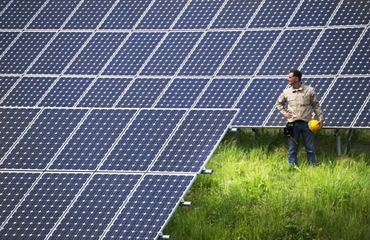
The U.S. Strengthened its Climate Pledge. Will Other Countries Follow Suit?
The Inflation Reduction Act isn’t perfect, but the U.S. blueprint for major emissions reductions is on the table for the world to see.
By Leonardo Lacerda, Global Managing Director, Climate; Darci Vetter, Global Head, Policy and Government Relations
Signed into law in August, the Inflation Reduction Act (IRA) represents the single biggest climate investment in U.S. history—by far.
The landmark law invests $369 billion in renewable energy, zero carbon transportation, clean manufacturing, community resilience, and natural climate solutions.
These investments deliver on a long list of priorities that The Nature Conservancy promotes to drive down greenhouse gas emissions, build more resilient communities, and enhance equitable outcomes.
Our global insights, straight to your inbox
Get our latest research, insights and solutions to today’s sustainability challenges.
Sign Up for newslettersRebuilding trust after Paris
Science tells us that in order to avoid the most catastrophic impacts of climate change, we need to keep global temperatures below a 1.5-degree rise from pre-industrial levels. This is simply not possible without the U.S. taking action. The IRA would put the U.S. on a path to roughly 40% emissions reduction by 2030.
The Paris Agreement was built on trust between countries that they would all take action together, and not create economic disparities between those who act and those who do not.
When the U.S. pulled out of the Paris Agreement, other countries questioned why they should continue to reduce their own emissions if the U.S. wasn’t. But when the U.S. reversed course last year and put forward a new commitment pledging 50-52% reductions, the globe noticed. Some trust returned, and it was not a surprise to see other major economies such as Canada, Japan and China soon enhance their own targets.
Quote

The U.S. has at last delivered the blueprint for HOW it will reduce emissions, which we hope results in other countries following suit and strengthening their own pledges.
Delivering a blueprint for how
While the U.S. return to Paris was greeted with hope, it also came with skepticism. Would the U.S. be able to transform its promise into action? How could the U.S. meet its 50-52% pledge without domestic legislation?
The U.S. has at last delivered the blueprint for HOW it will reduce emissions, which we hope results in other countries following suit and strengthening their own pledges.
The IRA is expected to generate rapid new deployment of renewable energy in the U.S., creating healthy competition for renewable energy technologies, which should reverberate to decrease prices and barriers to adoption globally. Tax credits for the purchase of electric vehicles, and continued incentives for other energy-saving technologies should also drive production and demand that will benefit consumers beyond U.S. borders.
Implementation of the IRA is also an opportunity to learn, and to share what the U.S. learns with other governments looking to spur climate action. Transparency about the use of the IRA’s incentives, how costs and benefits are shared across geographies and communities, and unanticipated barriers to adoption will be critical to ensuring that our efforts are efficient, effective, and just.

Quote
We are not yet on target to meet the 1.5-degree goal. But each time one country ratchets its emissions down, the globe’s chances improve.
Stand Up for Real Climate Action
Now is the time to dedicate ourselves to a low-carbon future.
Sign the PledgeMore aggressive steps to realize the role nature can play
The IRA does not contain everything we hoped for. We will need further, aggressive steps to transform our economy to renewable energy, and we will need additional measures to ensure that we fully realize the role nature can play in mitigation and adaptation.
We are not yet on target to meet the 1.5-degree goal. But each time one country ratchets its emissions down, the globe’s chances improve. TNC stands ready to work alongside our government and industry leaders to demonstrate pathways that can deliver deeper mitigation and adaption strategies and help people and nature.
About the Authors

Leonardo Lacerda
Leonardo Lacerda is TNC’s Global Managing Director for Climate Change, where he oversees the organization’s work to advance climate change solutions in mitigation, adaptation, and energy transition.

Darci Vetter
Darci Vetter is TNC’s Global Head of Policy and Government Relations, and an expert in international trade, agriculture and environmental policy.
Global Insights
Check out our latest thinking and real-world solutions to some of the most complex challenges facing people and the planet today.


